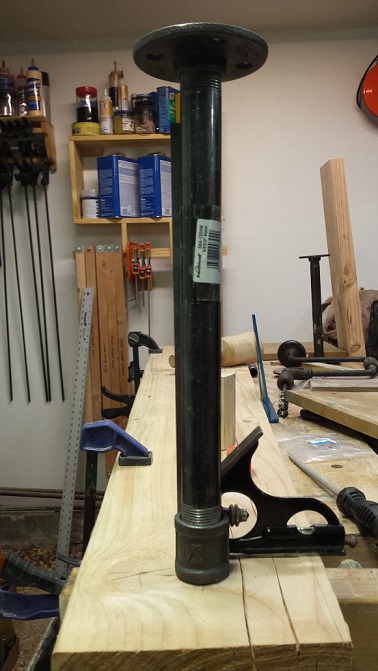07-11-2017, 03:24 AM
Sorry for the bad pun. Questions about drilling.
My wife's boss asked me to knock together for her a weird live edge table from a camphor slab she picked out to fit a weird alcove in her house (above the switchback in the stair case) that is 5' deep, 3 feet wide at the opening, but only 6 inches wide at the back . Gas pipe legs. The plan is for the pipe to be screwed to the bottom of the table top (which weighs about 20 lbs) with floor flanges and pass through the stretcher (which weighs about 16 lbs) and rest on floor flanges.


Just for general information, this was a 9' slab I crosscut in half, and the bottom half will be the top and the narrower upper half will be the bottom stretcher.


I bought a BORG 2 X 12 to use as a mock up, and I am practicing on that, as well as checking for the stability of the design (the tripod thing has me worried). I used my big as* brace (thanks, Admiral!) to drill a 3/4 inch hole (my biggest bit) (thanks, Admiral!), and reamed it out to the outside diameter of the pipe (which seems to be 1 1/16") with a rasp. Didn't go so well, I overshot by a bit and came in at 1 and 3/32. I have a couple pictures of the slop--out of camera view I am pushing gently on the pipe to the left and right to show y'all the extent of the slop. I felt pretty confident that my 3/4 inch holes were bored plumb; I'm pretty sure I introduced the out of plumbness with the rasping.






All that rasping took quite a while (I was going slow and careful and test fitting every few rasp strokes), and it still came out pretty meh. Is there a better way? How would you guys have tackled fitting the pipe? Any merit in using a swept carving gouge and treating the situation as a mortise?
BTW, here is how I did the rasping: I cut back to my outside diameter circle just about a 1/16" down into the hole, so that I had, essentially, a 1/16" bevel that landed on a shoulder inside the hole. When the pipe stood on that plumb, I flipped the board over and repeated the process. Then I tried to remove just the wood that formed the shoulder, filing back to the outside diameter circle. Is that the best technique, or is there a better way?
Would really like the remainder of the holes to come out much better than this one did. Any advice and suggestions gratefully accepted.
My wife's boss asked me to knock together for her a weird live edge table from a camphor slab she picked out to fit a weird alcove in her house (above the switchback in the stair case) that is 5' deep, 3 feet wide at the opening, but only 6 inches wide at the back . Gas pipe legs. The plan is for the pipe to be screwed to the bottom of the table top (which weighs about 20 lbs) with floor flanges and pass through the stretcher (which weighs about 16 lbs) and rest on floor flanges.

Just for general information, this was a 9' slab I crosscut in half, and the bottom half will be the top and the narrower upper half will be the bottom stretcher.

I bought a BORG 2 X 12 to use as a mock up, and I am practicing on that, as well as checking for the stability of the design (the tripod thing has me worried). I used my big as* brace (thanks, Admiral!) to drill a 3/4 inch hole (my biggest bit) (thanks, Admiral!), and reamed it out to the outside diameter of the pipe (which seems to be 1 1/16") with a rasp. Didn't go so well, I overshot by a bit and came in at 1 and 3/32. I have a couple pictures of the slop--out of camera view I am pushing gently on the pipe to the left and right to show y'all the extent of the slop. I felt pretty confident that my 3/4 inch holes were bored plumb; I'm pretty sure I introduced the out of plumbness with the rasping.



All that rasping took quite a while (I was going slow and careful and test fitting every few rasp strokes), and it still came out pretty meh. Is there a better way? How would you guys have tackled fitting the pipe? Any merit in using a swept carving gouge and treating the situation as a mortise?
BTW, here is how I did the rasping: I cut back to my outside diameter circle just about a 1/16" down into the hole, so that I had, essentially, a 1/16" bevel that landed on a shoulder inside the hole. When the pipe stood on that plumb, I flipped the board over and repeated the process. Then I tried to remove just the wood that formed the shoulder, filing back to the outside diameter circle. Is that the best technique, or is there a better way?
Would really like the remainder of the holes to come out much better than this one did. Any advice and suggestions gratefully accepted.
If you're gonna be one, be a Big Red One.






 If you decide to give up on drilling:
If you decide to give up on drilling: